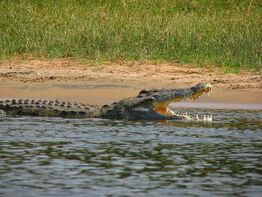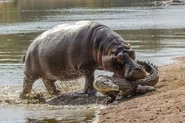
Nile Crocodile in Gulu, Uganda
The Nile crocodile (Crocodylus niloticus) is an African crocodile and may be considered the second largest extant reptile in the world, after the saltwater crocodile (Crocodylus porosus). The Nile crocodile is quite widespread throughout Sub-Saharan Africa, occurring mostly in the central, eastern, and southern regions of the continent and lives in different types of aquatic environments such as lakes, rivers and marshlands. Although capable of living in saline environments, this species is rarely found in saltwater, but occasionally inhabits deltas and brackish lakes. The range of this species once stretched northward throughout the Nile, as far north as the Nile delta. On average, the adult Nile crocodile can range between 2.8 and 5 m (9 ft 2 in and 16 ft 5 in) in length and weigh around 70 to 700 kg (150 to 1,540 lb). However, specimens exceeding 6.1 m (20 ft 0 in) in length and weighing more than 907 kg (2,000 lb) have been recorded. They have thick scaly skin that is heavily armored.
The Nile crocodile is an opportunistic apex predator and a very aggressive species of crocodile that is capable of taking almost any animal within its range. They are generalists, taking a variety of prey. Their diet consists mostly of different species of fish, reptiles, birds and mammals. The Nile crocodile is an ambush predator and can wait for hours, days and even weeks for the suitable moment to attack. They are quite agile predators and wait for the opportunity for the prey item to come close within the range of attack. Even swift prey are not immune to attack. Like other crocodiles, Nile crocodiles have an extremely powerful bite that is unique amongst all animals and sharp conical teeth that sink into flesh allowing for a grip that is almost impossible to loosen. They can apply high levels of force for extended periods of time, a great advantage for holding down large prey underwater to drown.
Nile crocodiles are relatively social crocodiles. They share basking spots and large food sources such as schools of fish and big carcasses. There is a strict hierarchy, that is determined by size. Large, old males are at the top of this hierarchy and have primary access to food and the best basking spots. Crocodiles know their place in the hierarchical order and rarely act against it, but when they do, the results are very bloody and sometimes even fatal. Like other reptiles, Nile crocodiles lay eggs to reproduce, which are guarded by the female. The hatchlings are also protected for a period of time, but hunt by themselves and are not fed by the parents. The Nile crocodile is one of the most dangerous species of crocodile and is responsible for hundreds of deaths of humans every year. It is a rather common species of crocodile and is not endangered despite some regional declines or extinctions.
Characteristics and physiology[]
Adult Nile crocodiles have a dark bronze colouration above, with faded blackish spots and stripes variably appearing across the back and a dingy off-yellow on the belly, although mud can often obscure the crocodile’s actual colour. The flanks, which are yellowish-green in colour, have dark patches arranged in oblique stripes in highly variable patterns. There is some variation relative to environment; specimens from swift-flowing waters tend to be lighter in colour than those dwelling in murkier lakes or swamps, which provides camouflage that suits their environment, an example of clinal variation. Nile crocodiles have green eyes. The colouration also helps to camouflage it; juveniles are grey, multicoloured, or brown, with dark cross-bands on the tail and body. The underbelly of young crocodiles is yellowish green. As it matures, the Nile crocodiles becomes darker and the cross-bands fade, especially those on the upper-body. A similar tendency is coloration change during maturation has been noted in most crocodile species.
Most morphological attributes of Nile crocodiles are typical of crocodilians as a whole. Like all crocodilians, for example, the Nile crocodile is a quadruped with four short, splayed legs, a long, powerful tail, a scaly hide with rows of ossified scutes running down its back and tail, and powerful, elongated jaws. Their skin has a number of poorly understood integumentary sense organs (ISOs) that may react to changes in water pressure, presumably allowing them to track prey movements in the water. The Nile crocodile has much reduced osteoderms on the belly, which are much more conspicuous on some of the more modestly sized crocodilians. The species does, however, also small oval osteoderms on the sides of the body as well as the throat. The Nile crocodile shares with all crocodilians a nictitating membranes to protect the eyes and lachrymal glands to cleanse its eyes with tears. The nostrils, eyes, and ears are situated on the top of the head, so the rest of the body can remain concealed underwater. They have a four-chambered heart, although modified for their ectothermic nature due to an elongated cardiac septum, physiologically similar to the heart of a bird, which is especially efficient at oxygenating their blood. As in all crocodilians, Nile crocodiles have exceptionally high levels of lactic acid in their blood which allow them to sit motionless in water for up to 2 hours. Levels of lactic acid as high as they are in a crocodile would kill most vertebrates. However, exertion by crocodilians can lead to death due to increasing lactic acid to lethal levels which in turn leads to failure of the animal’s internal organs. This is rarely recorded in wild crocodiles, normally having been observed in cases where humans have mishandled crocodiles and put them through overly extended periods of physical struggling and stress.































